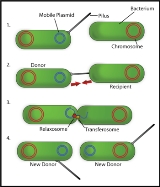
Bacterial conjugation
Overview
Bacterial conjugation is the transfer of genetic material between bacterial cells by direct cell-to-cell contact or by a bridge-like connection between two cells. Discovered in 1946 by Joshua Lederberg
and Edward Tatum, conjugation is a mechanism of horizontal gene transfer
as are transformation
and transduction
although these two other mechanisms do not involve cell-to-cell contact.
Bacterial conjugation is often incorrectly regarded as the bacteria
l equivalent of sexual reproduction
or mating
since it involves the exchange of genetic material.
Joshua Lederberg
Joshua Lederberg ForMemRS was an American molecular biologist known for his work in microbial genetics, artificial intelligence, and the United States space program. He was just 33 years old when he won the 1958 Nobel Prize in Physiology or Medicine for discovering that bacteria can mate and...
and Edward Tatum, conjugation is a mechanism of horizontal gene transfer
Horizontal gene transfer
Horizontal gene transfer , also lateral gene transfer , is any process in which an organism incorporates genetic material from another organism without being the offspring of that organism...
as are transformation
Transformation (genetics)
In molecular biology transformation is the genetic alteration of a cell resulting from the direct uptake, incorporation and expression of exogenous genetic material from its surroundings and taken up through the cell membrane. Transformation occurs naturally in some species of bacteria, but it can...
and transduction
Transduction (genetics)
Transduction is the process by which DNA is transferred from one bacterium to another by a virus. It also refers to the process whereby foreign DNA is introduced into another cell via a viral vector. Transduction does not require cell-to-cell contact , and it is DNAase resistant...
although these two other mechanisms do not involve cell-to-cell contact.
Bacterial conjugation is often incorrectly regarded as the bacteria
Bacteria
Bacteria are a large domain of prokaryotic microorganisms. Typically a few micrometres in length, bacteria have a wide range of shapes, ranging from spheres to rods and spirals...
l equivalent of sexual reproduction
Sexual reproduction
Sexual reproduction is the creation of a new organism by combining the genetic material of two organisms. There are two main processes during sexual reproduction; they are: meiosis, involving the halving of the number of chromosomes; and fertilization, involving the fusion of two gametes and the...
or mating
Mating
In biology, mating is the pairing of opposite-sex or hermaphroditic organisms for copulation. In social animals, it also includes the raising of their offspring. Copulation is the union of the sex organs of two sexually reproducing animals for insemination and subsequent internal fertilization...
since it involves the exchange of genetic material.

